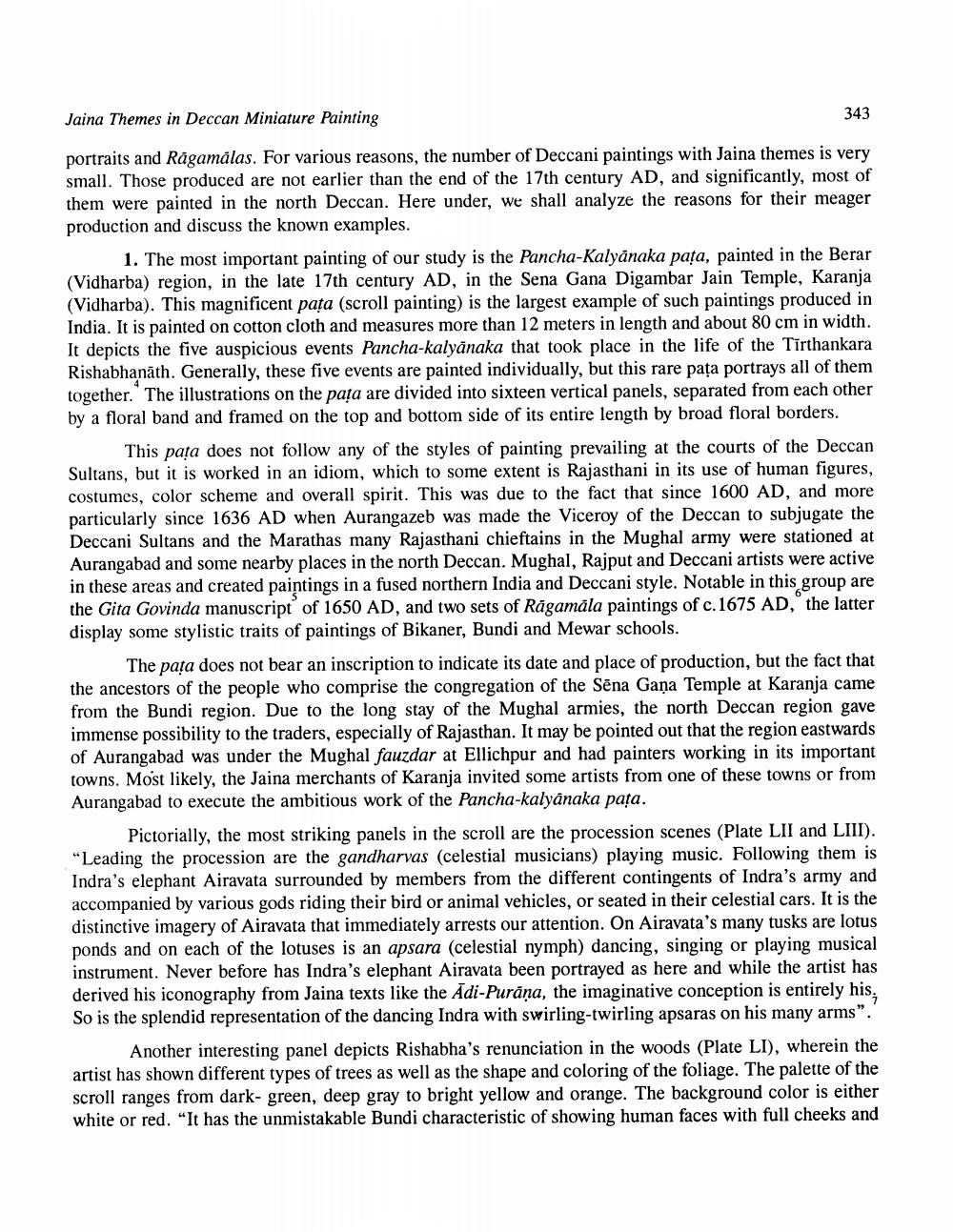________________
Jaina Themes in Deccan Miniature Painting
343
portraits and Rāgamálas. For various reasons, the number of Deccani paintings with Jaina themes is very small. Those produced are not earlier than the end of the 17th century AD, and significantly, most of them were painted in the north Deccan. Here under, we shall analyze the reasons for their meager production and discuss the known examples.
1. The most important painting of our study is the Pancha-Kalyānaka pata, painted in the Berar (Vidharba) region, in the late 17th century AD, in the Sena Gana Digambar Jain Temple, Karanja (Vidharba). This magnificent pața (scroll painting) is the largest example of such paintings produced in India. It is painted on cotton cloth and measures more than 12 meters in length and about 80 cm in width. It depicts the five auspicious events Pancha-kalyānaka that took place in the life of the Tirthankara Rishabhanāth. Generally, these five events are painted individually, but this rare pața portrays all of them together. The illustrations on the pața are divided into sixteen vertical panels, separated from each other by a floral band and framed on the top and bottom side of its entire length by broad floral borders.
This pata does not follow any of the styles of painting prevailing at the courts of the Deccan Sultans, but it is worked in an idiom, which to some extent is Rajasthani in its use of human figures, costumes, color scheme and overall spirit. This was due to the fact that since 1600 AD, and more particularly since 1636 AD when Aurangazeb was made the Viceroy of the Deccan to subjugate the Deccani Sultans and the Marathas many Rajasthani chieftains in the Mughal army were stationed at Aurangabad and some nearby places in the north Deccan. Mughal, Rajput and Deccani artists were active in these areas and created paintings in a fused northern India and Deccani style. Notable in this group are the Gita Govinda manuscript of 1650 AD, and two sets of Rāgamåla paintings of c. 1675 AD, the latter display some stylistic traits of paintings of Bikaner, Bundi and Mewar schools.
The pata does not bear an inscription to indicate its date and place of production, but the fact that the ancestors of the people who comprise the congregation of the Sena Gana Temple at Karanja came from the Bundi region. Due to the long stay of the Mughal armies, the north Deccan region gave immense possibility to the traders, especially of Rajasthan. It may be pointed out that the region eastwards of Aurangabad was under the Mughal fauzdar at Ellichpur and had painters working in its important towns. Most likely, the Jaina merchants of Karanja invited some artists from one of these towns or from Aurangabad to execute the ambitious work of the Pancha-kalyanaka pața.
Pictorially, the most striking panels in the scroll are the procession scenes (Plate LII and LIII). "Leading the procession are the gandharvas (celestial musicians) playing music. Following them is Indra's elephant Airavata surrounded by members from the different contingents of Indra's army and accompanied by various gods riding their bird or animal vehicles, or seated in their celestial cars. It is the distinctive imagery of Airavata that immediately arrests our attention. On Airavata's many tusks are lotus ponds and on each of the lotuses is an apsara (celestial nymph) dancing, singing or playing musical instrument. Never before has Indra's elephant Airavata been portrayed as here and while the artist has derived his iconography from Jaina texts like the Adi-Purāņa, the imaginative conception is entirely his, So is the splendid representation of the dancing Indra with swirling-twirling apsaras on his many arms".
Another interesting panel depicts Rishabha's renunciation in the woods (Plate LI), wherein the artist has shown different types of trees as well as the shape and coloring of the foliage. The palette of the scroll ranges from dark-green, deep gray to bright yellow and orange. The background color is either white or red. "It has the unmistakable Bundi characteristic of showing human faces with full cheeks and




